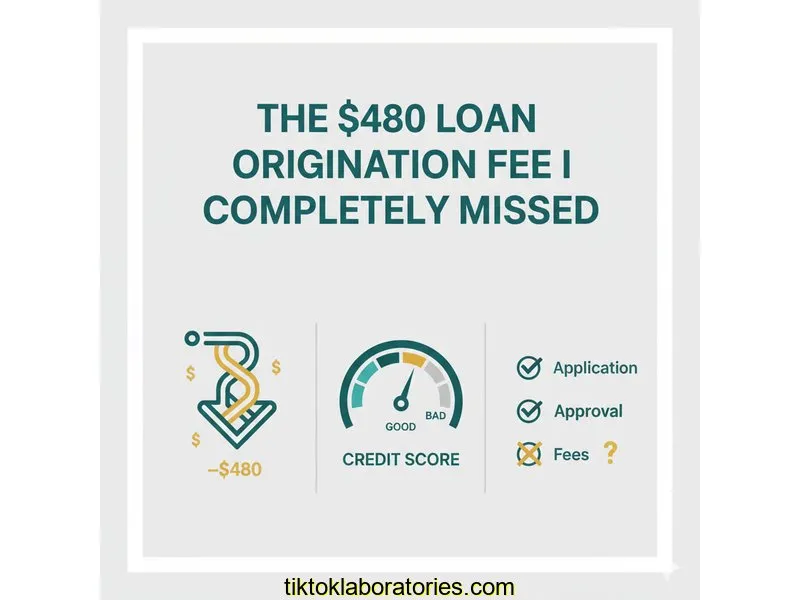
Auto Loan Calculator
Calculate payments over the life of your Loan
Home Blog Privacy Terms About Contact
Calculate payments over the life of your Loan
Home Blog Privacy Terms About ContactPublished on October 12, 2025

The scent of fresh paint and the sight of a half-assembled crib should be exciting. For me, in the fall of 2022, it was a source of mounting anxiety. My wife and I were expecting our first child, and our tiny spare room, which had served as a chaotic home office, needed a complete transformation into a safe, serene nursery. We were on a tight deadline, and the budget was even tighter.
We mapped it all out: new flooring, a custom closet system to maximize space, updated electrical outlets, and a fresh coat of non-toxic paint. The total came to just over $12,000. It was more than we had in savings, but it felt essential. So, I did what millions of people do: I turned to the internet for a personal loan. How hard could it be?
In my mind, the process was simple. You find a lender with a low interest rate, you fill out a form, and the money appears. I felt confident, even a little bit savvy. I spent an evening browsing online lenders, drawn in by slick interfaces and promises of "instant approval" and "rates as low as..." One lender, in particular, caught my eye with a headline rate of 11.99%. It seemed reasonable, and their calculator showed a monthly payment of around $399 for a 36-month term. Perfect. It fit our budget.
The pressure was immense. Every day felt like a day lost. I just wanted the money sorted so we could pay the contractor's deposit and get started. That urgency became my blind spot. I was so focused on the finish line—a completed nursery—that I started sprinting through the process. I filled out the application in less than 15 minutes, uploaded my documents, and felt a wave of relief when the "Congratulations, you're approved!" email landed in my inbox. I had solved our problem. Or so I thought.
Let me be crystal clear before I go any further: this is my personal story, detailing a mistake I made and what I learned from it. I am not a financial advisor, and this is not financial advice. My experience is my own, and your situation will undoubtedly be different.
The approval email felt like a victory. The loan agreement was a multi-page digital document, and I admit, I did what I suspect many people do. I scrolled. I scanned for the big numbers I already knew: $12,000 loan amount, 11.99% interest rate, 36-month term. Everything looked familiar. I clicked "I Agree," signed digitally, and closed my laptop with a satisfying snap.
Two business days later, I eagerly checked my bank account. The deposit had arrived. But as I stared at the screen, my heart did a funny little flip. The number wasn't right. The deposit was for $11,520. My mind started racing. Was it a typo? Did the bank make a mistake? Maybe the rest was coming in a separate transfer? A knot of confusion and dread began to form in my stomach.
I immediately logged back into the lender’s online portal. I clicked through every tab, my frustration growing. Everything still showed a loan amount of $12,000. It made no sense. Finally, I navigated to the "Documents" section and re-opened the loan agreement I had so quickly skimmed just days before. This time, I read it. Slowly. Line by painful line.
And then I saw it. Buried in a dense paragraph on the Truth in Lending Act (TILA) disclosure page, a document designed to promote the informed use of consumer credit, was the phrase: "Origination Fee: 4%." My eyes scanned down to a table that broke down the numbers. Loan Amount: $12,000. Origination Fee (deducted from proceeds): $480. Amount Financed (Funds Paid to You): $11,520. The missing $480 wasn't missing at all—it had been taken before the money ever reached me.
My stomach dropped. It felt like a magic trick where I was the fool. The monthly payment of $399 was calculated on the full $12,000 I was borrowing, but the cash I actually received to pay for the nursery renovation was $480 short. That was the entire budget for the new blackout curtains and the rocking chair my wife had her heart set on. In the grand scheme of a renovation it might not sound like a fortune, but when every single dollar is accounted for, a surprise shortfall of that size is a full-blown crisis. The relief I had felt just 48 hours earlier was replaced with a hot flush of embarrassment and anger, mostly at myself.
The loan was already disbursed; there was no going back. My initial anger quickly gave way to a determined resolve. I couldn't change what had happened, but I could make sure I understood it so completely that I would never make a similar mistake again. This became a mission to educate myself on the true cost of borrowing, moving beyond the flashy headline rates.
My first step was learning the crucial difference between an interest rate and the Annual Percentage Rate (APR). The 11.99% was the simple interest rate, the cost of borrowing the money itself. The APR, however, is a broader measure of cost that includes the interest rate *plus* any fees, like my dreaded origination fee. My loan's APR was actually closer to 13.8%, a much less attractive number. The fee, spread out over the loan's life, made the loan significantly more expensive than I believed.
My old self would stop at the advertised interest rate. My new self immediately scrolls down to find the range of possible APRs. I now know that the APR is the only way to get an apples-to-apples comparison between loan offers, because it standardizes the inclusion of certain fees.
From my experience, this document is the most important piece of the puzzle. Instead of being the last thing I glance at, it's now the first thing I would look for. I'd open it and use my browser's search function (Ctrl+F) to look for keywords like "fee," "origination," "prepayment," and "APR."
I learned that I shouldn't assume anything is free. For any future loan, I would make a list of questions to ask a lender's representative or search for in their FAQ, specifically: "Is there an origination fee? If so, is it a flat rate or a percentage? Is it deducted from the loan proceeds or added to the balance?"
Finally, I would ignore all the marketing and just focus on two numbers: the exact dollar amount that will land in my bank account, and the exact total of all my monthly payments combined. The difference between those two numbers is the true, all-in cost of the loan. No fancy terms, just simple, hard math.
The ultimate result of this ordeal wasn't a better loan deal—it was too late for that. We had to pull the $480 from our emergency fund, which added a layer of financial stress we didn't need. But the real result was a priceless education. The frustration I felt forced me to become a more careful, meticulous, and informed consumer. That knowledge is worth far more than the $480 I lost.

Going through that stressful experience taught me to slow down and create a mental checklist. This isn't advice for anyone else, but rather the system I developed for myself to avoid repeating my mistake. It’s about building a process to protect my own financial well-being.
In the weeks after discovering the fee, my mind replayed the event over and over. I found myself wrestling with a few key questions. These are the conclusions I came to, based purely on my own situation and research.
What I learned was that, no, it wasn't illegal. Origination fees are a common practice for some lenders, especially in the online space, to cover the costs of processing and underwriting a loan. The fee was disclosed in the federally required TILA document. The issue wasn't its legality; it was my failure to see it and factor it into my decision. My personal takeaway is that what is legal isn't always what's best for my wallet.
Looking back, the biggest clue was the difference between the "interest rate" and the "APR" listed in the fine print. If the APR is significantly higher than the interest rate, it's a giant red flag for me now that there are fees baked in. The TILA disclosure is the other key. I now see it as a "cheat sheet" that lays out all the costs, and I'll never ignore it again.
This was a surprising lesson for me. My gut reaction was to say "yes," but I realized it's more nuanced. What I believe now is that it depends on the total cost. A loan with a 5% APR and a 3% origination fee might still be cheaper over its lifetime than a loan with an 8% APR and no origination fee. The only way to know is to do the math on the total cost of borrowing for each offer. The fee itself isn't the enemy; making an uninformed decision is.
In my experience, without a doubt, it was rushing. The emotional pressure of the baby's arrival created a sense of urgency that overrode my logical thinking. I wanted to check "secure financing" off my to-do list so badly that I didn't give the process the respect and attention it deserved. This experience taught me that when it comes to money, slowing down is almost always the fastest way to get a good result.
That $480 fee taught me more than any book or article ever could. It was an expensive lesson, for sure, but a permanent one. The single most important takeaway for me was this: the headline number is just an advertisement. The real story of any financial product is always, always in the details—the fine print, the disclosure documents, and the fee schedule.
I managed to patch the budget together for the nursery, and when our daughter arrived, the stress of the loan faded into the background. But the lesson stuck with me. It changed the way I approach every financial decision, from signing up for a new credit card to reviewing my insurance policies. I am more patient, more skeptical, and far more diligent.
If you're navigating a similar path, all I can offer is the benefit of my mistake. Slow down. Read everything. Ask questions until you are 100% confident you understand. Making a mistake is human, but learning from it is how we grow. And always remember, this is just my personal story. Always consult with a qualified financial advisor for your specific situation.
All the best,
- Alex
Disclaimer: This article documents my personal experience with a loan application/process. This is not financial advice. Your own situation, creditworthiness, and loan options will differ. Always consult with a qualified financial advisor, review all loan documents carefully, and compare multiple lenders before making any financial decisions. Loan terms, rates, and fees vary by lender and borrower qualifications.
About the Author: Written by Alex, someone who has navigated personal loans, made mistakes, and learned from them over 8+ years of managing personal finances. I'm not a financial advisor or loan officer—just someone sharing personal experiences to help others avoid the mistakes I made. Always seek professional financial guidance for your specific situation.